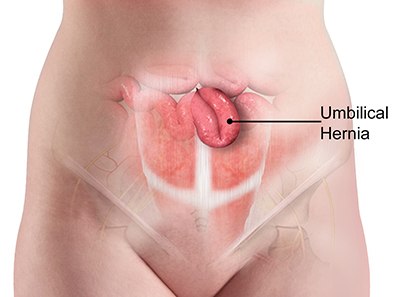Umbilical Hernia Surgery

What are Umbilical/ Paraumbilical Hernias?
An umbilical or paraumbilical hernia is a weakness in the abdominal wall at or near the navel through which the contents of the abdomen protrude to form a bulge. This area of weakness is in the region where the umbilical cord used to pass prior to birth. The bulge is caused by the protrusion of bowel or fatty tissue.
What Causes Umbilical Hernias?
As a foetus, the umbilical cord passes through an opening between the abdominal muscles (at the navel) that usually closes soon after birth. This closure, however, may not always be complete and thereby resulting in a weakened area where a hernia may develop later in life.
Umbilical herniae are in fact quite common in infants, especially in premature babies, but many would resolve with closure of the defect/opening at the navel at some months afterwards.
Unfortunately in adults, connective tissue around the navel and the surrounding abdominal wall degenerates through the process of aging which allows this area to weaken with a resultant risk for an umbilical hernia to form. This is further mediated by an increase in pressure inside the abdomen leading to a bulge or protrusion of an internal organ out of the abdomen. Some of the factors that contribute to the development of a hernia through the chronic increase in pressure are persistent coughing, obesity, constipation, and frequent heavy lifting. Herniae are also more common in pregnancy, smokers, previous abdominal surgery, and in certain connective tissue disorders.
Symptoms
Symptoms depend on the contents of the hernia and whether it can be pushed back inside the abdomen (reducibility).
If the hernia contains protrusion of fat, then it may only cause pain. If the hernia contains bowel that cannot be pushed back in, then it may cause pain, redness/discoloration of the overlying skin, bowel obstruction, and gangrenous bowel in the protruding segment. This situation is a surgical emergency that requires an urgent operation.
Diagnosis of Umbilical and Paraumbilical Hernia
Diagnosis of these conditions primarily involve in review of medical history and a thorough physical examination to identify the hernia, its likely contents and whether they can be reduced back into the abdominal cavity. An abdominal x-ray may be ordered to confirm or rule out an associated bowel obstruction.
Treatment for Umbilical and Paraumbilical Hernia
Hernia containing irreducible bowel/fat requires urgent surgical consultation in the hospital.
In the non-emergency setting, surgery is usually recommended for symptomatic hernia or those containing bowel in the hernia. It may also be performed for the undesirable cosmesis of a hernial bulge.
Surgery for Umbilical / Paraumbilical Hernia
The operation is performed under general anaesthesia. A small incision above or below the navel is performed to access the hernia contents and push them back into the abdominal cavity. The sac formed by the hernia is removed.
If the defect/opening at the hernia is small, then this will be closed with permanent, non-absorbable sutures on the inside.
If the defect/opening is large enough, then synthetic material (a mesh) would be used to repair the abdominal wall defect using “tension-free” principles to reduce the risk of hernia recurrence after surgery. The mesh provides a scaffold for the incorporation and integration of scar tissue. The skin at the incision is closed with absorbable stitches.
Preparation for Umbilical and Paraumbilical Repair
You should notify your surgeon of any allergies or any medications you are taking. You may be asked to stop taking certain medications prior to surgery. The anaesthetist will perform an evaluation prior to your surgery and may guide you through this as well. Before undergoing any operation, you are required to fast for 6 hours beforehand.
Recovery after Umbilical and Paraumbilical Repair
Following surgery, you will be taken to a recovery room where your vital signs are closely monitored. Once the local anaesthetic wears off, you will gradually experience some pain which can be controlled by pain-killers. You are usually allowed to go home on the same day of the surgery if it is performed in the morning or early afternoon. However, you may be required to stay in hospital overnight if the surgery is performed late in the day. You will receive instructions on how to care for the surgical site, but it is very important that smoking is avoided as it can delay healing. No heavy lifting is allowed for 6 weeks after surgery to avoid the early recurrence of hernia.
